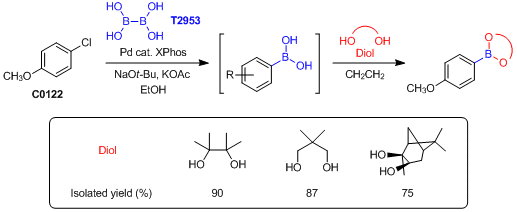Published TCIMAIL newest issue No.197
Maximum quantity allowed is 999
CAS RN: 13675-18-8 | Numéro de produit: T2953
Tetrahydroxydiboron

Pureté:
- Tetrahydroxydiborane
- Diboronic Acid
- Hypodiboric Acid
- BBA
- Bis-Boric Acid
| Taille | Prix unitaire | Belgique | Japon * | Quantité |
|---|---|---|---|---|
| 5G |
€71.00
|
3 | ≥40 |
|
| 25G |
€248.00
|
1 | 9 |
|
*Le délai de livraison pour des produits disponibles en stock en Belgique est 1 à 2 jours
*Le délai de livraison pour des produits disponibles en stock en Japon est 1 à 2 semaines (sauf des produits réglementés et des envois avec de la glace carbonique)
| Numéro de produit | T2953 |
| Formule moléculaire / poids moléculaire | H__4B__2O__4 = 89.65 |
| Etat physique (20 ° C) | Solid |
| Condition de stockage | Room Temperature (Recommended in a cool and dark place, <15°C) |
| CAS RN | 13675-18-8 |
| Numéro de registre de Reaxys | 14723923 |
| Identifiant de la substance PubChem | 253660323 |
| Numéro MDL | MFCD05663888 |
| Appearance | White to Almost white powder to crystal |
| Purity(Neutralization titration) | 98.0 to 110.0 % |
| Point de fusion | 290 °C |
| Solubilité (soluble dans) | Methanol |
| Pictogramme |

|
| Mot de signal | Attention |
| Mentions de danger | H315 : Provoque une irritation cutanée. H319 : Provoque une sévère irritation des yeux. |
| Conseils de prudence | P264 : Se laver la peau soigneusement après manipulation. P280 : Porter des gants de protection/ un équipement de protection des yeux/ du visage. P302 + P352 : EN CAS DE CONTACT AVEC LA PEAU: Laver abondamment à l’eau. P337 + P313 : Si l'irritation oculaire persiste: consulter un médecin. P362 + P364 : Enlever les vêtements contaminés et les laver avant réutilisation. P332 + P313 : En cas d'irritation cutanée: consulter un médecin. |
| N ° SH (import / export) (TCI-E) | 2810009000 |

-
Used Chemicals
-
Procedure
-
To a solution of trans-4-nitrostilbene (1.13 g, 5.00 mmol), diboronic acid (1.34 g, 15.0 mmol, 3.0 eq.) in DMF (30 mL) was added 4,4’-bipyridyl (3.9 mg, 0.025 mmol, 0.50 mol%) at r.t. and the mixture was stirred at the same temperature for 1 hour. The reaction mixture was diluted by 1 mol/L NaHCO3 aq. (100 mL) and the resulting solid was filtered off. The solid was purified by column chromatography (dichloromethane:hexane = 0:1 - 4:1 on silica gel) to give trans-4-aminostilbene as a yellow solid (891 mg, y. 91%).
-
Experimenter’s Comments
-
The reaction mixture was monitored by UPLC.
-
Analytical Data
-
trans-4-Aminostilbene
1H NMR (270 MHz, CDCl3); δ 7.47 (d, 2H, J = 7.0 Hz), 7.38-7.30 (m, 4H), 7.21 (t, 1H, J = 7.0 Hz), 7.03 (d, 1H, J = 15 Hz), 6.91 (d, 1H, J = 15 Hz), 6.63 (d, 2H, J = 8.6 Hz), 3.75 (brs, 2H).
-
Lead Reference
-
- Metal-Free, Rapid, and Highly Chemoselective Reduction of Aromatic Nitro Compounds at Room Temperature

To an oven-dried glass vessel is added (X-Phos) palladium(II) phenethylamine chloride (7.38 mg, 0.01 mmol), X-Phos (9.52 mg, 0.02 mmol), tetrahydroxydiborane, (133.5 mg, 1.5 mmol), KOAc (294 mg, 3 mmol), and NaOt-Bu (1 mg, 0.01 mmol). The vessel is evacuated and backfilled with N2 (three times). EtOH (10 mL degassed) is added followed by the addition of 4-chloroanisole (1 mmol). The reaction is then heated to 80 °C for 18 hours. The reaction is cooled to rt then filtered through a thin pad of Celite (eluting with EtOAc) and concentrated. To the residue is added 1 M aqueous HCl and EtOAc (25 mL each). This mixture is stirred 30 min and the aqueous layer is removed, and the organic layer is washed with brine. The combined aqueous layers are extracted with EtOAc (3 x 10 mL). The combined organics are dried (Na2SO4) and then concentrated. The crude mixture is taken up in CH2Cl2, the corresponding diol is added (1.35 mmol), and the crude reaction is allowed to stir at rt. At completion of the reaction, the reaction is concentrated, and the residue is purified by flash column chromatography to afford the desired aryl boric acid derivatives.
References
- 1)Palladium-Catalyzed, Direct Boronic Acid Synthesis from Aryl Chlorides: A Simplified Route to Diverse Boronate Ester Derivatives
Articles / Brochures
[Product Highlights] Diboronic Acid Usable for the Direct Synthesis of Aromatic Boric Acid Derivatives
Fiche de sécurité (FDS)
La FDS demandée n'est pas disponible.
Nous contacter pour plus d'informations.
Spécifications
CoA et autres Certificats
Exemple de CoA
Un échantillon CoA pour ce produit n'est pas disponible pour le moment.
Graphiques analytiques
Le tableau analytique demandé n'est pas disponible. Nous sommes désolés pour ce désagrément.





